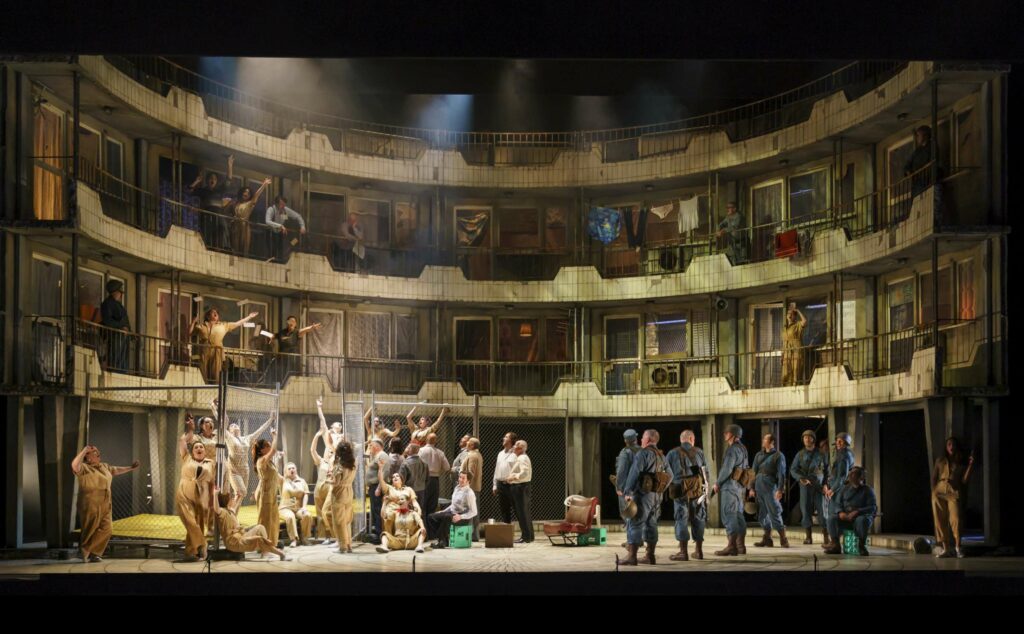
The perfect balance of accessibility and enchantment, Carmen provides an in-between of West-end theatrics and operatic skill.
Carmen is one of the more renowned operas and this rendition from the Welsh National Opera has been immensely popular, bringing it back for their spring season. Unlike other opera’s I’ve seen, not all the text used was sung but there was a split between spoken moments and song. This blend of familiarity meant that Carmen provided an easily accessible route into opera, especially for those that are already used to seeing musical productions. Carmen bared various resemblances to musicals I’ve seen prior such as Miss Saigon; this was both in setting and the dynamics throughout the show. Therefore, there was more breath and pause from the mixture of song and text which meant that as a whole, the opera felt much shorter to the audience watching (which I’m sure we know from the Harry Potter films is extremely important).
Throughout the whole of the piece, the ensemble were extremely invested in their own roles and their individual plots within the piece. This gave substance to the main storyline and the audience could easily follow that throughout. The children were incredible, taking their roles with maturity and giving true investment into their parts. My only criticism, being that you could notice when they were waiting for prompts which is no fault of their own but due to a lesser understanding and experience of improvising to fill the time.
It was the moments in which the focus was on the ensemble that stay with me from the performance. Examples being: The children, mocking the guards in their barracks, bringing a whirlwind of my life and joy to the stage, The women from the tobacco factory, with their relentless desire and allure, The gun smuggling scene, hiding weapons within various props and what you saw was completely different to that of the person sat next to you due to the variety and depth of what was occurring on stage, And finally, the light-hearted scene outside of the bullring, with street vendors and people haggling for refreshments.
The use of sound coming from the stage during these moments were wonderful. There were made by the ensemble to accompany the orchestra and added a sense of true passion coming from the performers. When they stamped stools, clapped and slapped their body parts, the full stage came alive radiating towards the audience.
I found the main characters struggled with their realism, especially within moments of intimacy. When Carmen kisses Jose, the kiss feels distant as the characters aren’t close enough, I almost desired a real kiss to fulfil those moments. It seems to be these moments between Jose and Carmen that lacked their depth, another example being when Carmen hits Jose with a towel but does it so softly that the anger doesn’t seep through in the way intended. In opposition to this, Escamillo embodies his character wonderfully, portraying himself in such a way that the audience dislikes his arrogance. However, physically, when posing and using stronger gestures, he needed to be more over the top and exaggerated to really stay true to his characters’ aurora.
There were moments of confusion throughout the piece for the audience, especially in regards as to what was being sang by whom. The subtitles didn’t repeat, even when a character did. Also, when two characters were singing a call and response section, this failed due to them both singing both parts combined with the lack of captions above. In order to fix the problems within the call and response between characters, it could require something as simple as just spatial re-alignment. By moving the characters to different parts of the stage, the audience would be forced to look from character to character and therefore, from one side to the other which would ensure the audience understands the conversations being had.
To conclude, I think Carmen is the perfect gateway between a musical and an opera. With song, dance and text, the audience is immersed throughout the performance and is moved alongside the storyline with the characters. However, I feel this rendition needed more work with the small details, those that change a performance into excellence. By working on the physicality of the main characters and fine tuning on key moments, the whole storyline would become easier to follow to the audience.
